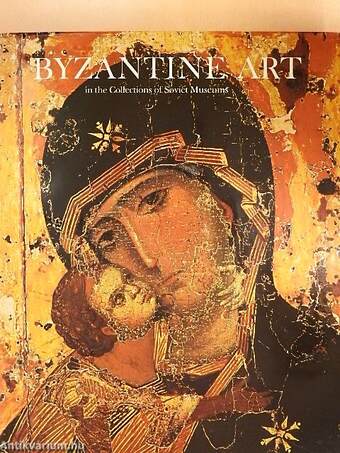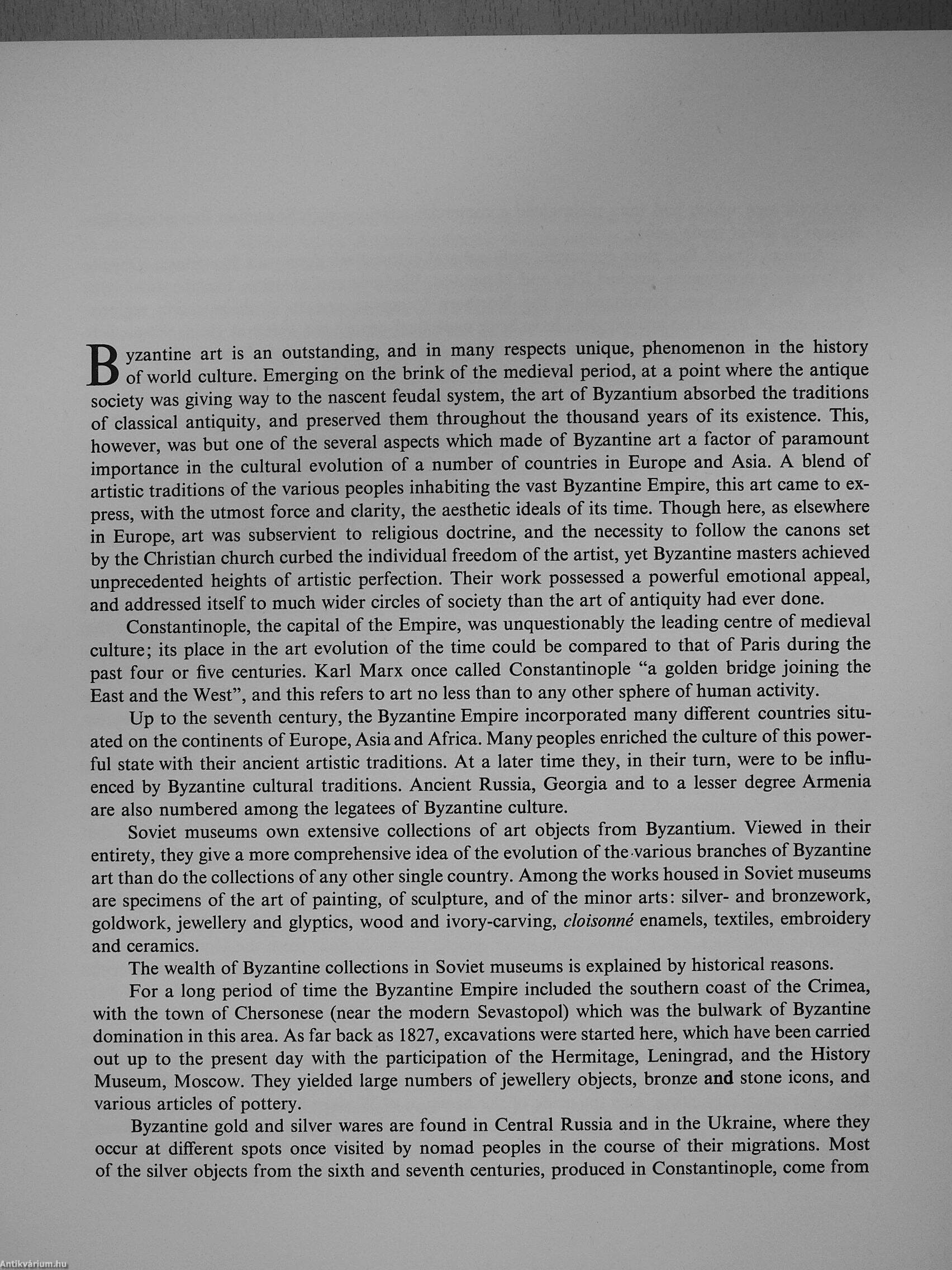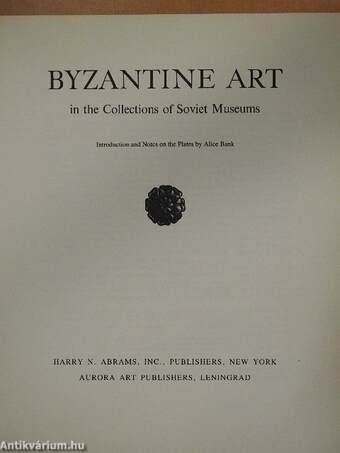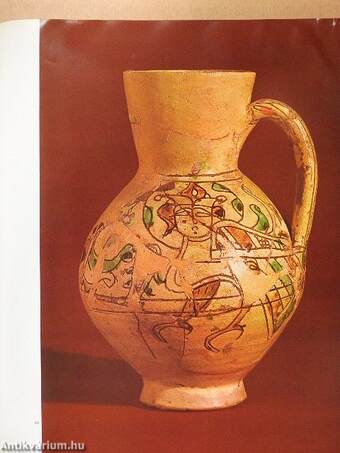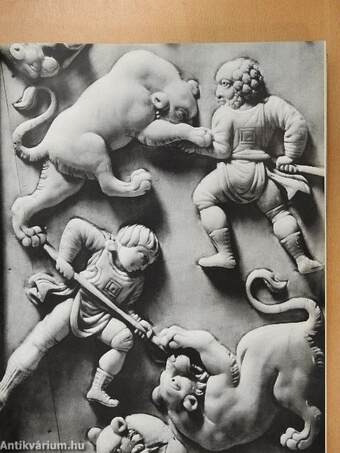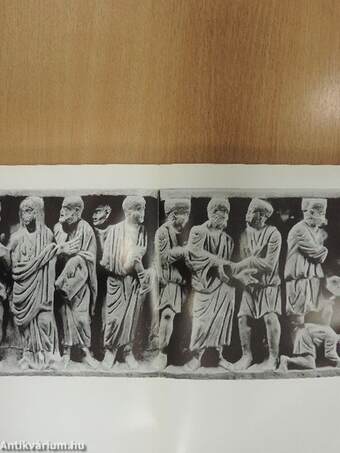1.062.389
kiadvánnyal nyújtjuk Magyarország legnagyobb antikvár könyv-kínálatát

VISSZA
A TETEJÉRE
JAVASLATOKÉszre-
vételek
Byzantine art
In the Collections of Soviet Museums
| Kiadó: | Harry N. Abrams, Inc.-Aurora Art Publishers |
|---|---|
| Kiadás helye: | New York-Leningrád |
| Kiadás éve: | |
| Kötés típusa: | Vászon |
| Oldalszám: | 337 oldal |
| Sorozatcím: | |
| Kötetszám: | |
| Nyelv: | Angol |
| Méret: | 33 cm x 27 cm |
| ISBN: | |
| Megjegyzés: | Fekete-fehér és színes reprodukciókkal illusztrálva, kihajtható melléklettel. |
naponta értesítjük a beérkező friss
kiadványokról
naponta értesítjük a beérkező friss
kiadványokról
Előszó
TovábbFülszöveg
BYZANTINE ART
IN THE COLLECTIONS OF SOVIET MUSEUMS
Extraordinarily elegant, colorful, sensual, Byzantine art quickly lures the viewer into its world. This volume with illustrations in color, was produced in the Soviet Union, whose museums contain the most comprehensive collections of Byzantine art in the world. Among the treasures chosen for reproduction in this book are specimens of the art of painting, of sculpture, and of the minor arts: silver and bronzework, goldwork, jewelry and glyptics, wood- and ivory-carving, cloisonné enamels, textiles, embroidery, and ceramics.
Byzantine art is an outstanding, and in many respects unique, phenomenon in the history of world culture. Emerging on the brink of the medieval period, at a point where the antique society was giving way to the nascent feudal system, the art of Byzantium absorbed the traditions of classical antiquity, and preserved them throughout the thousand years of its existence. A blend of artistic traditions of the... Tovább
Fülszöveg
BYZANTINE ART
IN THE COLLECTIONS OF SOVIET MUSEUMS
Extraordinarily elegant, colorful, sensual, Byzantine art quickly lures the viewer into its world. This volume with illustrations in color, was produced in the Soviet Union, whose museums contain the most comprehensive collections of Byzantine art in the world. Among the treasures chosen for reproduction in this book are specimens of the art of painting, of sculpture, and of the minor arts: silver and bronzework, goldwork, jewelry and glyptics, wood- and ivory-carving, cloisonné enamels, textiles, embroidery, and ceramics.
Byzantine art is an outstanding, and in many respects unique, phenomenon in the history of world culture. Emerging on the brink of the medieval period, at a point where the antique society was giving way to the nascent feudal system, the art of Byzantium absorbed the traditions of classical antiquity, and preserved them throughout the thousand years of its existence. A blend of artistic traditions of the various peoples inhabiting the vast Byzantine Empire, this art came to express, with the utmost force and clarity, the aesthetic ideals of its time.
Up to the seventh century, the Byzantine Empire incorporated many different countries situated on the continents of Europe, Asia and Africa. Many peoples enriched the culture of this powerful state with their ancient artistic traditions. At a later time they, in their turn, were to be influenced by Byzantine cultural traditions. Ancient Russia, Georgia and to a lesser degree Armenia are also numbered among the legatees of Byzantine culture.
The evolution of European art during the centuries which followed the fall of the Empire could not be properly understood without due regard to the artistic legacy left by Byzantium. The role of Byzantine art was not, by far, confined to that of a carrier of the antique traditions. Successful efforts to achieve the synthesis of the arts; a strong emotional tension; an interest in human psychology; an outstanding compositional mastery; a strong feeling of monumental form; a keen sense of color; and a remarkable skill of conveying much by saying little -all these aspects of Byzantine art make it a great art in its own right, and give it a place of honor in the cultural history of mankind.
319 illustrations, including 188 plates in full color Vissza
Témakörök
- Idegennyelv > Idegennyelvű könyvek > Angol > Művészetek > Fotóművészet
- Idegennyelv > Idegennyelvű könyvek > Angol > Művészetek > Művészettörténet, általános
- Idegennyelv > Idegennyelvű könyvek > Angol > Vallás > Kereszténység
- Művészetek > Művészettörténet általános > Múzeumok, képtárak > Külföldi > Orosz
- Művészetek > Művészettörténet általános > Idegen nyelv > Angol
- Művészetek > Művészettörténet általános > Korszakok, stílusok > Középkor > Keresztény művészet
- Művészetek > Fotóművészet > Albumok > Tematikus
- Művészetek > Fotóművészet > Idegen nyelv > Angol
- Művészetek > Fotóművészet > Témái > Művészetek
- Vallás
- Vallás > Kereszténység > Egyházművészet



